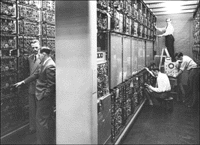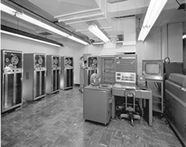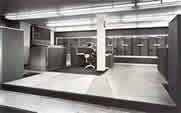 The SAGE (Semi Automatic Ground Enviroment) computer was one of the largest computers ever built, standing two stories tall. It required over 1 million watts of power, and held 200,000 vacuum tubes. When it became operational in 1955, it was the first digital computer used for a major military operation. It was used as an air defense system by the U.S. Air Force, gathering data from outlying radar stations for immediate evaluation. Capable of tracking nearly 400 planes at one of its 26 computer terminals, it provided computerized electronic defense against Russian bombers carrying nuclear weapons. It would coordinate radars and direct friendly plans to intercept.
The SAGE (Semi Automatic Ground Enviroment) computer was one of the largest computers ever built, standing two stories tall. It required over 1 million watts of power, and held 200,000 vacuum tubes. When it became operational in 1955, it was the first digital computer used for a major military operation. It was used as an air defense system by the U.S. Air Force, gathering data from outlying radar stations for immediate evaluation. Capable of tracking nearly 400 planes at one of its 26 computer terminals, it provided computerized electronic defense against Russian bombers carrying nuclear weapons. It would coordinate radars and direct friendly plans to intercept.
Weighing in at 250 tons, it gathered its information via telephone lines from as many as 100 radar stations and then processed and displayed it on one of it’s 50 cathode ray tube screens. The result of a massive 6 year development effort, it required 7000 person years of programming and cost around $61 billion.









